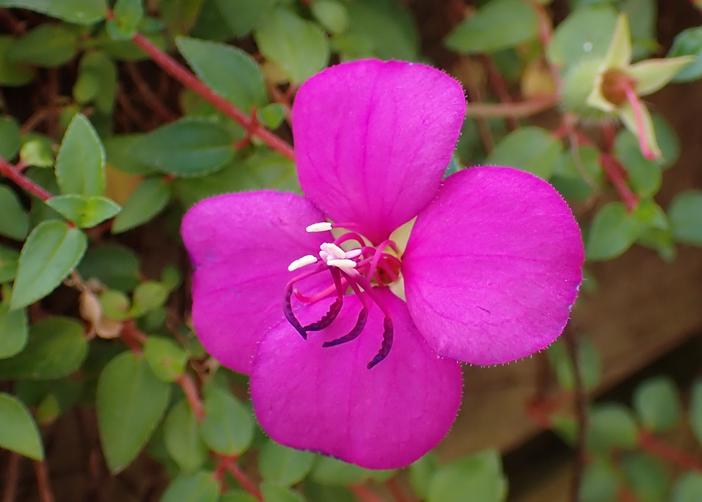Spanish Shawl
(Heterocentron elegans)
Spanish Shawl (Heterocentron elegans)
/
/

Krzysztof Ziarnek, Kenraiz
CC BY-SA 4.0
Image By:
Krzysztof Ziarnek, Kenraiz
Recorded By:
Copyright:
CC BY-SA 4.0
Copyright Notice:
Photo by: Krzysztof Ziarnek, Kenraiz | License Type: CC BY-SA 4.0 | License URL: https://creativecommons.org/licenses/by-sa/4.0 | Uploader: Kenraiz | Publisher: Wikipedia Commons














Estimated Native Range
Summary
Heterocentron elegans, commonly known as Spanish Shawl, is an evergreen perennial herb that originates from the understory of tropical forests in Central America and Southeast Mexico. It typically grows to a height of 0.4 feet (0.1 meters) and can spread up to 3 feet (0.9 meters), forming a dense mat of foliage. Spanish Shawl is characterized by its vibrant green leaves and profuse, small, fuchsia to purple flowers that bloom in summer and fall, adding a splash of color to the garden. The flowers are quite showy and can attract pollinators such as butterflies and hummingbirds.
Spanish Shawl is valued for its low-growing habit and long flowering season, making it an excellent choice for ground cover, hanging baskets, and as a spiller plant in container gardens. It is relatively easy to maintain, requiring only occasional pruning to keep it tidy. In cultivation, it thrives in full sun to part shade and prefers well-draining soil with consistent moisture. While it is generally pest-resistant, it can be susceptible to root rot if overwatered or planted in poorly draining soils. It is not known to be invasive when grown outside its native range, but gardeners should always monitor and manage their plants responsibly.CC BY-SA 4.0
Spanish Shawl is valued for its low-growing habit and long flowering season, making it an excellent choice for ground cover, hanging baskets, and as a spiller plant in container gardens. It is relatively easy to maintain, requiring only occasional pruning to keep it tidy. In cultivation, it thrives in full sun to part shade and prefers well-draining soil with consistent moisture. While it is generally pest-resistant, it can be susceptible to root rot if overwatered or planted in poorly draining soils. It is not known to be invasive when grown outside its native range, but gardeners should always monitor and manage their plants responsibly.CC BY-SA 4.0
Plant Description
- Plant Type: Herb
- Height: 0.5-1 feet
- Width: 1.5-3 feet
- Growth Rate: Moderate
- Flower Color: Purple, Pink
- Flowering Season: Summer, Fall
- Leaf Retention: Evergreen
Growth Requirements
- Sun: Full Sun, Part Shade
- Water: Medium
- Drainage: Medium
Common Uses
Low Maintenance
Natural Habitat
The understory of tropical forests
Other Names
Common Names: Trailing Lasiandra, Trailing Princess Flower, Pink Lady
Scientific Names: , Heterocentron elegans, Schizocentron elegans, Heterocentron sessilis, Heeria elegans, Monochaetum guatemalense, Heeria procumbens, Heterocentron sessile, Hypostate elegans, Rhexia elegans,
GBIF Accepted Name: Heterocentron elegans (Schltdl.) Kuntze